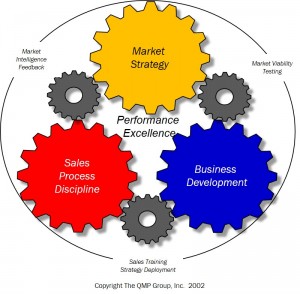Negotiations with procurement specialists in large organizations can really be brutal.
More than ever they seem to be driven by a sadistic combination of corporate edicts. These might include: sourcing overseas, reducing commodity costs by some per cent annually, reducing the number of suppliers by 20% and driving to 60-day payable policies – all while achieving the lowest piece-price possible.
These selling conditions define a prototypical “price-driven” market – though I have heard it called other things NSFW.
Sadly, some small B2B firms never actually do anything meaningful about these challenges. Year after year they eke out marginal success by squeezing their prices and margins, repeatedly trying to sell to the same hard-nosed customers, continually targeting the same markets and agreeing to be victimized by abusive procurement conditions.
There are ways to reduce the effects of these challenges. Some of the solutions are quick and some take time to develop. But, one thing is certain, if there is no action taken, there is no improvement likely.
Self-Diagnosis: A Reality Look in the Mirror
Step 1 is understanding what has brought you to this situation. If you are struggling with price-driven markets, one or more of the following statements are likely contributing:
- Your product offerings and your company actually have no meaningful differentiation
- You are aimed at the wrong markets and customers
- You are unable to quantify the economic value you can deliver
- You are doing a poor job of communicating your economically quantifiable value
- You have not established true strategic partnerships with your customers
The first step to freedom, is identifying which statement, or combination, is true.
Doing something about it.
Salvation can actually be easier than you might imagine. Here are some paths to consider.
Path 1: Market Refocus
You must focus on markets where your unique product and corporate capabilities have real meaning to customers.
A client of ours had a new product that was significantly price disadvantaged in the general market. Despite this reality, the new business development team was hustling to set up distributors across the country for that general market, betting on corporate approval of a major price reduction to spur sales – when, in fact, corporate was quietly considering shutting the product line down.
Surprisingly, some handful of customers had actually bought this grossly overpriced product – a certain hint that someone was seeing value that others were not. When asked “Why they bought?” those customers explained that the product, even at that exaggerated price, solved a unique set of problems for their situation.
By quickly shifting their sales focus to this market, the business was saved without any change in selling price. In fact, customers in that market requested additional features which eventually lifted the selling price to 4X its original.
Path 2: Understand, Quantify and Communicate Your Unique Economic Value
Everyone in your organization that deals with customers must be able to understand and communicate the economic value of your products.
A client was puzzled by the slowness with which their new product, designed specifically to help customers save substantial amounts of money, was not selling better. The choke point was discovered to be the distributor sales manager who simply did not believe the economic argument. He had quietly avoided promoting that benefit to his distributors, in spite of customer testimonials validating the savings.
A rapid individual re-education was required, followed by a re-training of the distribution sales force. Product sales turned up significantly shortly afterwards.
You cannot assume that your benefits are being accurately communicated. Check the communication choke points.
Path 3: Tell the Whole Story
Your customer cannot make a decision based on anything other than price if that is all she sees. There is much more than price that is critical to the success of a supply relationship. A single-page quote sheet cannot communicate that larger story.
Here are some items to consider. Each can create additional value around the price.
- Who is on the team you will dedicate to this supply relationship – their names, experience and roles? This information builds trust.
- What is the detailed schedule, timeline and check points? This information builds credibility.
- What approach will be used to assure success? What examples of this approach have been successful in the past? This information reduces perceived risk.
- What is the quality story? This information also reduces perceived risk.
A client of ours increased their bookings by 20% in just one deal using this “whole story” approach.
Path 4: Build a true partnership
A one-salesperson-to-one-procurement specialist link does not define a strong and defensible relationship – even if they play golf once a week and belong to the same ski club. Multiple connection points must be developed: engineering to engineering, quality to quality, customer service to planning, shipping to receiving, manufacturing to manufacturing. The trust that is built up by these multiple open communications channels has real value in terms of problem solving, getting things done and creating a strong tough-to-break bond.
Path 5: Challenge the Chief
I once asked a group of 12 B2B CEOs, during a talk to take out a blank sheet of paper and write down what they perceived as their best product offering – the product that they thought customers should appreciate the most.
I then asked them to identify the value factors delivered by that product. and calculate what economic benefit that ideal customer was likely to receive from that product. Remarkably, they stumbled. None of them could do it in the 15 minutes allotted.
If the CEO can’t do it, how can they expect it of the rest of their team? That kind of understanding and expectation sets the tone for the whole organization from engineering through shipping.
Final Words:
We have offered 5 diagnostic questions and five paths out of the briarpatch of a price-driven market. It will take some serious self-examination and require some analysis and thought, but it is definitely achievable.
*****
Copyright Jerry Vieira, CMC and The QMP Group, Inc. 2015 All Rights Reserved
If you’d like to learn more about dealing with price-based competition call Jerry Vieira, CMC at 503.318.2696 or email to Jerry@qmpassociates.com. The QMP Website is at www.TheQMPGroup.com and more insights can be found on the subjects of Market Strategy, Business Business Development and Sales at Jerry Vieira’s QMP Insights Blog. If you have an immediate challenge, please communicate it through our Contact Us page.












